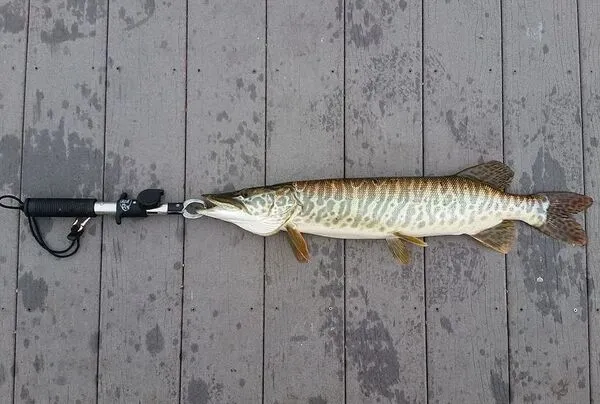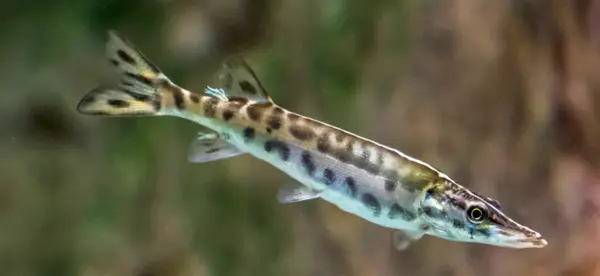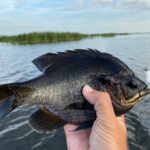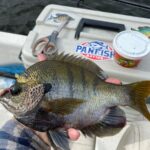Muskellunge, aka muskies, are renowned as one of the most aggressive of freshwater predators, willing to attack nearly anything in the water.
They’re apex predators, famous for their violent hits and great fight, but are muskie good to eat? And more importantly, should you eat such a highly prized gamefish?
Table of Contents
Are Muskie Good Eating?
If properly prepared, muskie are good to eat. However, in many areas, it’s probably better to catch and release them for conservation purposes.

Muskie are huge freshwater fish that can provide a lot of meat. Although their reputation as a game fish is stellar, many fishermen won’t eat them.
Rumors about eating muskie include ‘they’re too bony‘…’they taste like hydrilla‘…’they’re full of mercury‘…or ‘the meat is too strong‘..etc.
While some of these rumors may have truth to them, the reality is that muskie are edible and a good tasting fish when cooked and filleted properly.
But does that mean you should keep them for dinner?
Should Muskie Be Catch And Release Only?
First and foremost muskie are often released because they are a prized gamefish that is protected, and even endangered in some areas.
Anglers love to catch them, and they’re not easy to catch!
Another reason that fishermen may hesitate to eat them is their conservation status in areas where they’re native.
Like most apex predators, muskies reproduce slowly and not terribly efficiently. This is vital, otherwise, they would overwhelm and wipe out all the food sources in any body of water they live in!
Unfortunately, this slow reproduction also makes Muskellunge especially vulnerable to, and slow to recover from, overfishing. It takes seven years for a muskie to reach sexual maturity and to be ready to breed.
This means that most muskie under 3 feet in length haven’t bred yet. A year-old muskie is still usually only around a foot long and is vulnerable to predation by other types of fish, birds, or even another muskie!

Muskie grow slowly. This, combined with the low reproduction rate and the high loss of life before they even reach breeding age, means that the big monsters that dominate their rivers and lakes are very, very hard to replace.
In their native range, there are usually strict size and bag limits, with impressive consequences for any violation. In my opinion, catch and release is a better option in native waters.
When Is Okay To Keep Muskie?
However, there are many areas where muskie have been introduced and are considered invasive.
They can be devastating to native fish populations in these non-native areas and it’s common to have no size or bag limits.
In states like Alaska and Maine, releasing muskie is actually discouraged.
This is where you want to catch your muskies for eating!
What Does Muskie Taste Like?
Properly prepared muskie is a very firm, (some say tough) white meat, with a pink tint and has a mild flavor. Some even consider it bland and claim it needs spice or sauce, to give it flavor.
Muskie have been compared in flavor to both freshwater bass and northern pike.
Let me put it this way: Musky are much more popular for the allure and sporting qualities than they are for their taste as the dinner table.
Are Muskie Safe To Eat?
There are some safety concerns when eating muskie. This is not due to any innate toxicity in the fish itself, but rather, environmental contamination. Muskie are particularly prone to having high levels of mercury due to their position atop the food chain.
They’re voracious predators that eat anything and everything they can catch: fish, mammals, birds, amphibians, and reptiles.
Yes, musky have been known to eat ducks, mice, snakes and more!
Anytime they swallow a prey animal, they add its mercury load to their own.
Consequently, big muskies are generally old fish who have been gulping down everything they can get their teeth into for many years.
The general advice is that muskie should not be eaten more than once a month, and not more than six times a year. Children and women who are pregnant or nursing should avoid it altogether.
Can Muskie Be Eaten Raw?
Muskie is not great eaten raw. While it doesn’t normally harbor any diseases or parasites that can’t be killed by freezing, its toughness and flavor don’t make for great raw eating.
As a general rule, I do not recommend eating raw freshwater fish.
Is Muskie Good For You?
As long as you heed all necessary mercury warnings, muskie can be very healthy as an addition to your diet.
They’re a low-calorie, high-protein, low-carb option that gives a good dose of heart-healthy omega-3 fatty acid as well as many vitamins and minerals.
Muskie is great for people following low-carb, keto, carnivore, Whole 30, or any of several other healthy diets.
As with any fish, moderation and preparation play a big role in the health benefits.
How To Prepare Muskie
Note: Always be sure to check the local fishing rules and regulations in your area before harvesting any fish. There may be season closures, tag requirements or slot limits you must abide by.
Cleaning a muskie is very similar to cleaning a northern pike. These two fish are often confused for one another, but the process of getting clean boneless fillets is the same.
Start by slicing up from the pectoral fin to the back of the head and then run your knife down the ridge of the back to the tail.
Slowly work the filet off with your knife, passing over the ribs, until you’ve removed your filet.
With the filet skin side down, feel above the rib area for the Y-bones. You should be able to see them and will definitely be able to feel them.
Remove these with your knife. Check visually for any bones you may have missed.
Take the remaining filet and cut off all the skin. It’s very important that you don’t leave any skin behind; the skin will give the meat a nasty flavor.
Rinse the finished filets well, then put them in cold water and add some lemon juice. The lemon will remove any trace of any objectionable smell from the meat.
How To Cook Muskie
Muskie is a very versatile meat, due to its mild flavor. In fact, you’ll probably want to use recipes that add flavor to the meat since it can be considered a little bland.
Grinding is a common way to prepare muskie and will deal with any bones you may have missed.
A common muskie preparation is to grind it up to make fish cakes or use a food processor to make a fish mousse. Muskie substitutes nicely for crab in most recipes, so it’s great in soups, chowders, or stews that you would normally make with crab.
It’s good breaded and deep fried, and you can cook it any way you would cook bass.
Pan-fried with the spices and sauces of your choice is also popular, and this is often served with a side of dipping butter or sauce.
Final Thoughts
Remember, Muskie are a highly prized gamefish that is very susceptible to habitat loss, overfishing and low production rates.
Never keep a muskie unless you are following the harvest rules in your area, and if you do keep a muskie for food, please don’t take more than you need.
That being said, Muskie are edible, and capable of producing a good meal…particularly when you take the time to fillet out the small bones and cook them properly.
Thanks for reading!
If you haven’t guessed yet, I love fishing and everything about it!
To learn more about why I started Panfish Nation, visit the About page and follow along on Social Media:


Download a copy of my FREE Lure Color Selection Chart & Knot Guide!
Stay up to date with fishing reports, tackle reviews, industry news, and much more! We respect your privacy, unsubscribe at any time.
Related Posts
- Sauger vs Walleye: Learn These Differences and Catch More!
- Crazy Facts About the World Record Crappie
- What Size Hooks for Smallmouth Bass? Quick Guide
- Large and in Charge-Mouth: 10 of the Best Bass Lures of All Time (And Where to Buy Them)
- Emperor of the Sun(fish): What You Need to Know About the World Record Bluegill
- Coppernose Bluegills: How They’re Different from Common Bluegill






